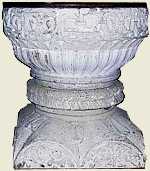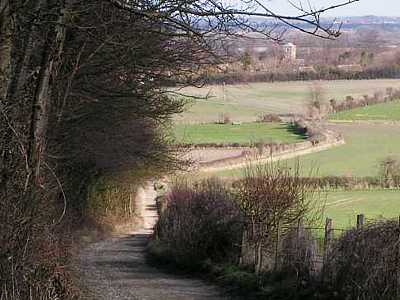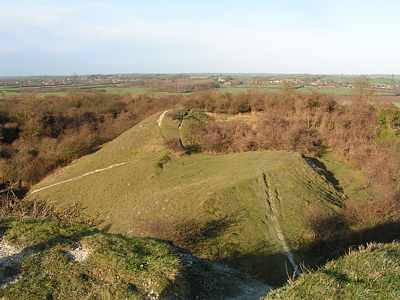
The 'Aylesbury' fonts.

The 'Aylesbury' fonts
In Buckinghamshire
Bledlow
Buckland
Chearsley
Chenies
Dinton
Great Hampden
Great Kimble
Great Missenden
Haddenham
Little Missenden
Ludgershall
Monks Risborough
Old Linslade
Pitstone
Saunderton
Weston Turville
Wing
In Bedfordshire
Barton-le-ClayFlitwick
Houghton Regis
In Northamptonshire
DustonEydon
There are some 22 'Aylesbury' fonts, named after one of the best examples in St. Mary's Church, Aylesbury, Buckinghamshire.
Two fonts in Buckinghamshire are a little further afield in Chenies and Ludgershall, while the two simpler ones in Northamptonshire, at Duston and Eydon, are much further away.
The Buckinghamshire fonts are at Aylesbury, Bledlow, Buckland, Chearsley, Chenies, Dinton, Great Hampden, Great Kimble, Great Missenden, Haddenham, Little Missenden, Ludgershall, Monks Risborough, Old Linslade, Pitstone, Saunderton and Weston Turville. (Old Linslade was in Bucks up until 1965).
Those at Chenies and Pitstone have been re-cut. Only the base exists at Wing where the present font is Perpendicular.
In Bedfordshire there are 'Aylesbury' fonts at Houghton Regis and Old Linslade with a simpler one at Flitwick. The font at Barton-le-Clay was recut in the 15th century and only the rope-moulded rim survives of the original. That at Old Linslade, although described as of the Aylesbury type, does not have the characteristic fluting on the bowl.
The fonts are cup or chalice-shaped with vertical fluting on the lower part of the bowl.
The finest are at Aylesbury, Great Kimble, Weston Turville and Houghton Regis (in Bedfordshire). That at Bledlow appears to be a locally made copy of the Great Kimble one and that at Monks Risborough, the base at Wing and possibly those at Great and Little Missenden are probably by the same workmen.
Decoration similar to that on the upper rim at Aylesbury and Weston Turville occurs on a late 12th century doorway at St. Albanís Abbey while a detail on a capital there resembles the decoration on the scalloped bases of these two fonts.
This suggests that the craftsmen responsible for the design of these fonts may have been trained at St. Albanís.
The chalice shape and decoration may have been inspired by the gold chalices made at St. Albanís at the same time.
There is a font in Zealand, Denmark, which closely resembles those at Aylesbury and Great Kimble and it is known that there were artistic connections between St. Albanís and Denmark at that time so patterns appear to have been exchanged.
 Track towards Bledlow Church.
Track towards Bledlow Church.
Two fonts in Buckinghamshire are a little further afield in Chenies and Ludgershall, while the two simpler ones in Northamptonshire, at Duston and Eydon, are much further away.
The Buckinghamshire fonts are at Aylesbury, Bledlow, Buckland, Chearsley, Chenies, Dinton, Great Hampden, Great Kimble, Great Missenden, Haddenham, Little Missenden, Ludgershall, Monks Risborough, Old Linslade, Pitstone, Saunderton and Weston Turville. (Old Linslade was in Bucks up until 1965).
Those at Chenies and Pitstone have been re-cut. Only the base exists at Wing where the present font is Perpendicular.
In Bedfordshire there are 'Aylesbury' fonts at Houghton Regis and Old Linslade with a simpler one at Flitwick. The font at Barton-le-Clay was recut in the 15th century and only the rope-moulded rim survives of the original. That at Old Linslade, although described as of the Aylesbury type, does not have the characteristic fluting on the bowl.
The fonts are cup or chalice-shaped with vertical fluting on the lower part of the bowl.

Quarries at Totternhoe
The finest are at Aylesbury, Great Kimble, Weston Turville and Houghton Regis (in Bedfordshire). That at Bledlow appears to be a locally made copy of the Great Kimble one and that at Monks Risborough, the base at Wing and possibly those at Great and Little Missenden are probably by the same workmen.
Decoration similar to that on the upper rim at Aylesbury and Weston Turville occurs on a late 12th century doorway at St. Albanís Abbey while a detail on a capital there resembles the decoration on the scalloped bases of these two fonts.
This suggests that the craftsmen responsible for the design of these fonts may have been trained at St. Albanís.
The chalice shape and decoration may have been inspired by the gold chalices made at St. Albanís at the same time.
There is a font in Zealand, Denmark, which closely resembles those at Aylesbury and Great Kimble and it is known that there were artistic connections between St. Albanís and Denmark at that time so patterns appear to have been exchanged.

Distribution map of the 'Aylesbury' fonts.
Although generally similar, the fonts are all different in every detail including the depth of the bowl, the number of flutes, the intricate design of the rim, the stem and the base.
However, they fall into 3 general categories depending on the design of the base.
In the first two categories the base is generally square resembling an inverted one- or two-scallop capital with the lunettes generally decorated. The stem (between the bowl and the base) is quite short but decorated with rope or chevron moulding.
The bowls of the Aylesbury, Buckland, Dinton, Old Linslade and Pitstone fonts have been broken and repaired. Some fonts as at Saunderton have the remains of the clasps to fasten the font cover to prevent people stealing the Holy Water.
At Great Kimble there are traces of medieval red paint on the bowl and the stem. It is suggested that this font was originally gilded to resemble a golden chalice and the red paint was an undercoat for the gilt.
However, they fall into 3 general categories depending on the design of the base.
In the first two categories the base is generally square resembling an inverted one- or two-scallop capital with the lunettes generally decorated. The stem (between the bowl and the base) is quite short but decorated with rope or chevron moulding.
-
One-scallop capitals.
These are at Chenies (plain lunettes), Houghton Regis, Little Missenden and Weston Turville.
At Great Missenden the bowl has been re-cut and the fluting and decorated rim have been destroyed.
-
Two-scallop capitals.
These are at Aylesbury, Bledlow and Great Kimble.
At Wing only the base remains. At Eydon (Northamptonshire) instead of the two scallops in each side of a square there are 8 scallops on an octagonal base!
- Other types of base. The remaining fonts have much simpler stems and the bases are circular, octagonal or square.
The bowls of the Aylesbury, Buckland, Dinton, Old Linslade and Pitstone fonts have been broken and repaired. Some fonts as at Saunderton have the remains of the clasps to fasten the font cover to prevent people stealing the Holy Water.
At Great Kimble there are traces of medieval red paint on the bowl and the stem. It is suggested that this font was originally gilded to resemble a golden chalice and the red paint was an undercoat for the gilt.
Details of the decoration
Rims
 Little Missenden font.
Little Missenden font.
At Aylesbury and Weston Turville the design is of repeated pairs of leaves in scrolls. At Chearsley there is a simple version of this.
Little Missenden has a horizontal series of 3-lobed leaves while Buckland, Eydon (Northamptonshire) and Saunderton have simpler leaf motifs.
At Haddenham and Old Linslade there are dragons in the frieze. At Pitstone the leaf motif consists of overlapping semi-circles. Great Hampden has fleurons. Those at Duston (Northamptonshire) and Flitwick (Bedfordshire) have roll rims.
At Houghton Regis there are two rows of ornaments. The upper row has foliate forms separated by vertical double rolls and the lower has triangular panels with 4-fluted lobes. The rim at Ludgershall has a narrow gadrooned band. At Dinton the upper part of the bowl was replaced, probably in the 14th or 15th century, and is decorated with arch-heads and quatrefoils.
Bowls
The depth of the bowl varies considerably from relatively shallow at Aylesbury, Eydon and Great Kimble to very deep at Chearsley.The number of flutes also varies from about 30 to 40. Whilst most bowls have a simple curved shape, that at Aylesbury is S-shaped. At Ludgershall the bowl is almost cylindrical and only the upper half is fluted with foliage at the foot of the flutes. The fluting at Haddenham differs from the others as it consists of a series of triangles. The flutes at Graet Hampden are very shallow.
Scalloped Bases
The stems between the bowl and the base are about 6 inches deep and consist of a series of cylinders of different diameters, some decorated with chevrons, others with a rope moulding. Except at Chenies, the lunettes are generally decorated with leaf patterns, that at Little Missenden being fleur-de-lys.At Houghton Regis three of the lunettes have 3,5 and 7 - lobed palmettes with leaves. The fourth side is damaged.
Other Bases
The bases of the other fonts are generally much simpler. However at Pitstone the stem below a rope moulding is tapered with a series of flutes above a circular base. At Great Hampden the foot has a big roll moulding with interlace. At Saunderton there is a shallow tapering decorated stem above an octagonal base.Buckland has a simple cylindrical stem over a circular base.
Chearsley has a tapered octagonal stem while the tapered stem at Monks Risborough is circular above a circular base of 3 different diameters.
Duston has a circular chamfered plinth on a circular step. The base and plinth at Flitwick are modern.
The fonts are shown in the photos with enlargements of the frieze details and the lunette decoration
On the Lower Terrace at Cliveden House is a fluted bowl with a decorated rim which closely resembles the Aylesbury Fonts. It is a Venetian well-head of the 15th or 16th century and there are two winged lions of St. Mark in the frieze.
Other Fonts
There are about 30 early fonts in Buckinghamshire varying from the simplicity of those at Little Kimble and Radnage to the very complex carvings including a man fighting a beast on the Norman bowl at Stone; however, this did not originate in Buckinghamshire but in Berkshire as it was moved from Hampstead Norris in about 1843.Those at Chalfont St. Giles, Denham, Iver and Taplow are of a table-top design while those at Little Kimble and Radnage may be late Saxon.
Photos of the 'Aylesbury' fonts
Further Reading:
"The Buildings of England - Buckinghamshire"
Nikolas Pevsner and Elizabeth Williamson
The Corpus of Romanesque Sculpture for fonts in Bedfordshire and Northamptonshire. Photos and references to these fonts on this website by permission of the Conway Library of the Courtauld Institute of Art.
"Baptismal Glory in South Buckinghamshire"
Victoria Turner Berks. Bucks. and Oxon. Life
of April 1975
"Flutes and Chalice-shaped"
Malcolm Thurleby Country Life Jan 28 1982
"The Buildings of England - Buckinghamshire"
Nikolas Pevsner and Elizabeth Williamson
The Corpus of Romanesque Sculpture for fonts in Bedfordshire and Northamptonshire. Photos and references to these fonts on this website by permission of the Conway Library of the Courtauld Institute of Art.
"Baptismal Glory in South Buckinghamshire"
Victoria Turner Berks. Bucks. and Oxon. Life
of April 1975
"Flutes and Chalice-shaped"
Malcolm Thurleby Country Life Jan 28 1982
email Ken
July 2007
K.A.Goodearl
Chorleywood
U.K.
K.A.Goodearl
Chorleywood
U.K.